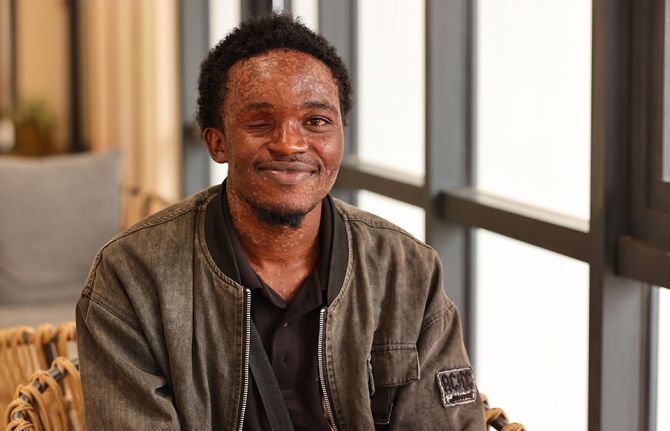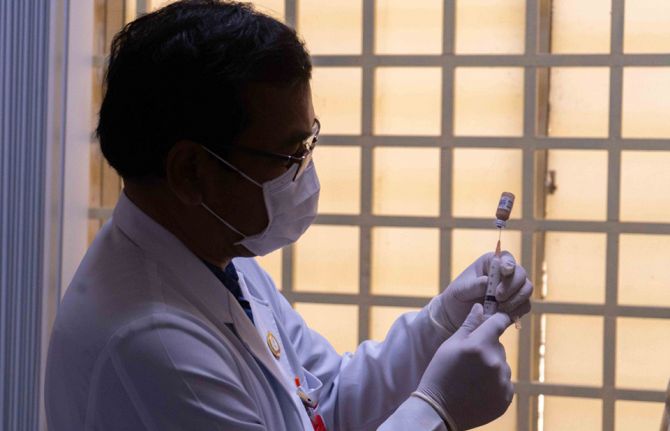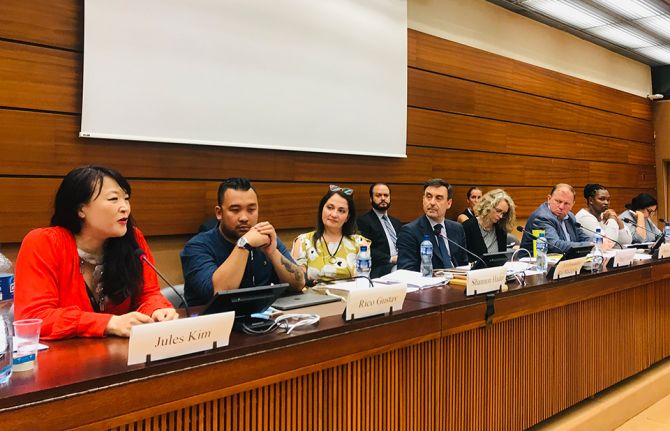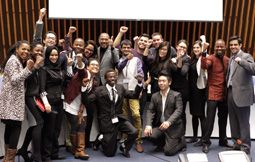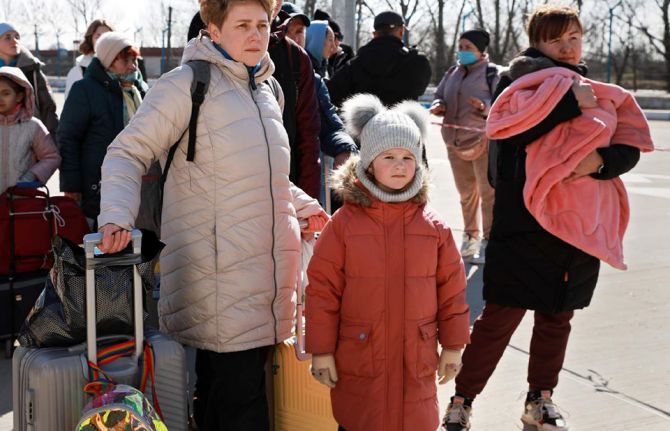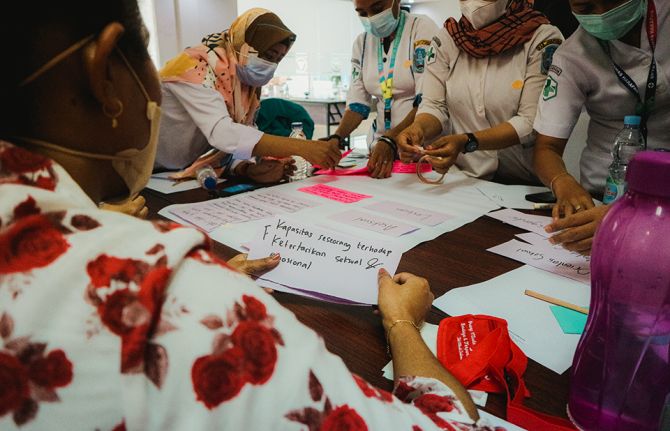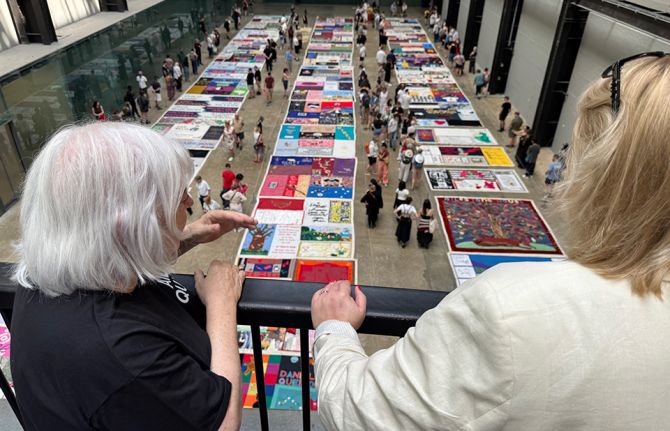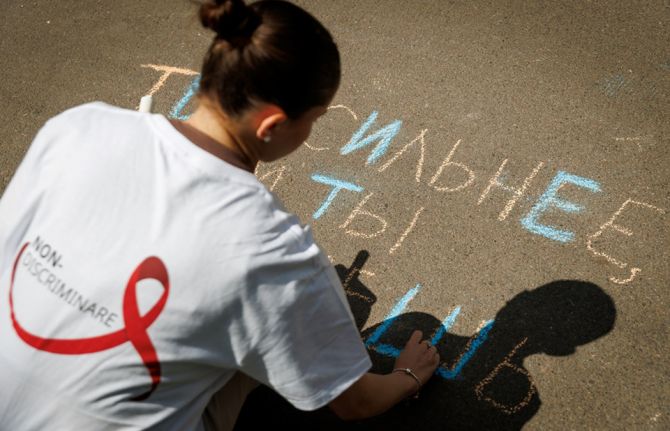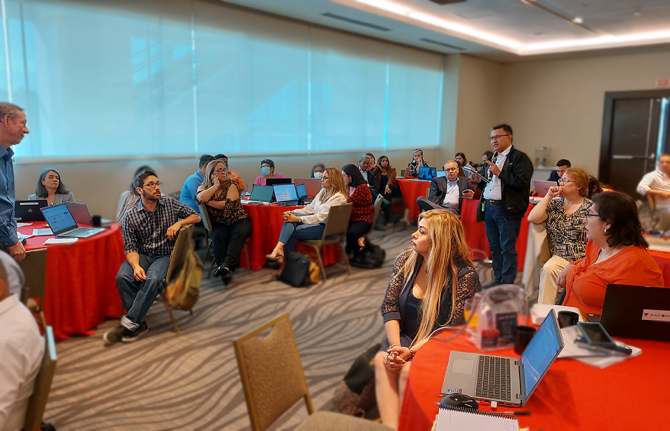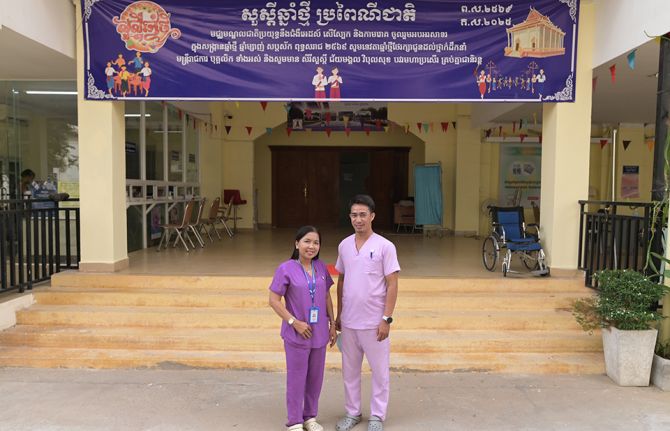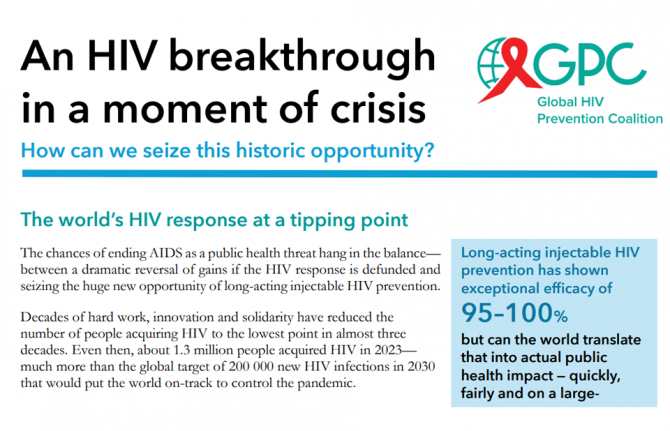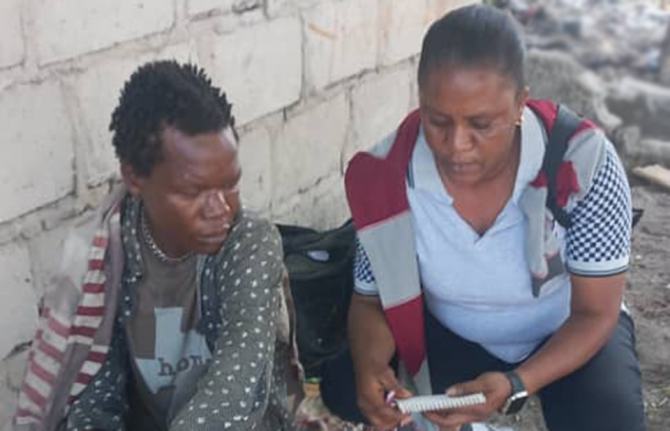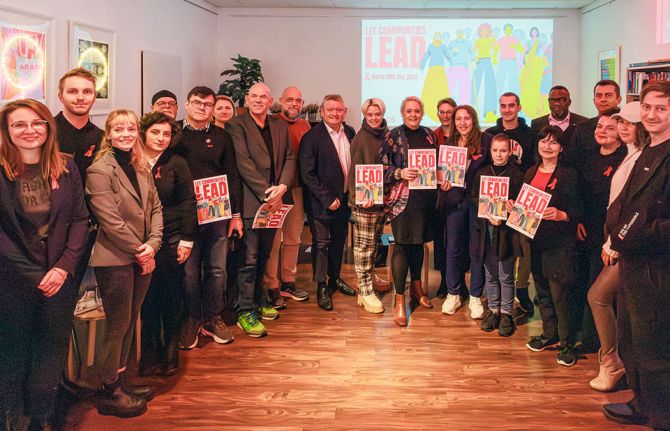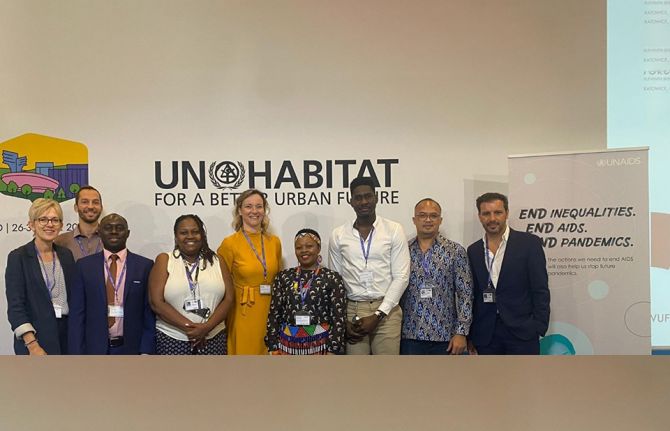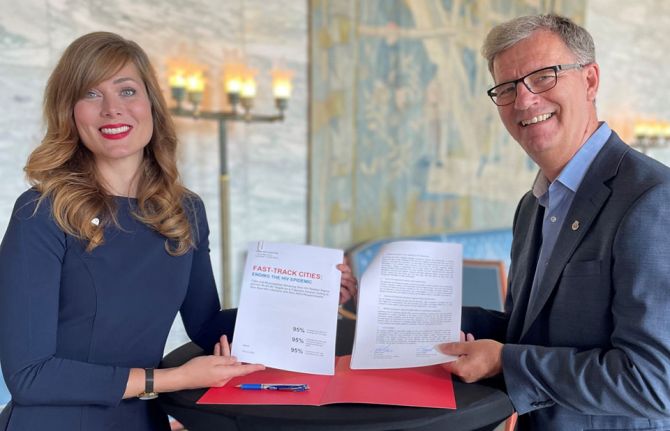
Feature Story
Next steps with 1% tenofovir microbicide gel
24 November 2010
24 November 2010 24 November 2010After nearly 20 years of research, the results of the CAPRISA 004 trial provided the first evidence that the use of a vaginal microbicide could provide a safe and effective way to prevent HIV infection in women.
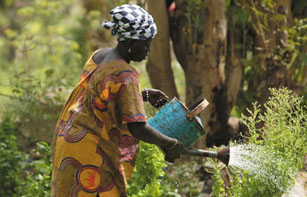
Following results from a South African study (CAPRISA 004) showing that a vaginal microbicide gel containing the antiretroviral drug tenofovir was 39% effective in reducing a woman’s risk of becoming infected with HIV during sex, WHO and UNAIDS convened a meeting in August 2010, just a month following the announcement, to review the implications of the CAPRISA 004 results and determine the appropriate next steps.
The meeting participants agreed on the below priority actions for follow-up:
- Additional safety studies;
- Effectiveness trial in South Africa to confirm the CAPRISA 004 BAT 24 dosing regimen;
- Effectiveness and safety trial of simplified dosing and HIV testing schedules;
- Implementation study in South Africa; and,
- Treatment outcome and resistance study.
To find out more, read the executive summary of the meeting report , or download the full report.
Related

Feature Story
Waiting for the world to change: Travel restrictions
23 November 2010
23 November 2010 23 November 2010A version of this story first appeared in 2010 UNAIDS OUTLOOK report
For many of the millions of people living with HIV around the world, travel restrictions are a daily reminder that they do not have the freedom to move internationally—or, even worse, that they may have to leave the place they call home.
Some 49 countries, territories and areas currently impose some form of travel restriction on the entry, stay and residence of people based on their HIV status.

When Mark Taylor,* a Canadian citizen working for a company in New York’s financial sector, fell in love with his life in the Big Apple, he never gave it a second thought to apply for permanent residency in the United States of America. It was 1995 and he was thriving both professionally and personally.
“My new employer said it would sponsor my permanent residency, and we began the process of obtaining all of the required approvals,” Mr Taylor said.
In early 2002, with his residency paperwork completed, Mr Taylor was advised to have a medical exam in Canada to speed up the process.
“When I went to pick up the results, I was told that the HIV test had come back positive. As you might expect, I was devastated. I had been HIV negative the last time I took the test in Canada. Not only did I have to worry about my health and well-being, but I was sure that I would be forced to leave New York, my job and all the friends I had there. I immediately sank into a deep depression, feeling hopeless and helpless.”
For the 22 years the USA had a travel ban on people living with HIV. Life stories like Mr Taylor’s were not uncommon. It started in 1987, when the USA added HIV infection to a list of conditions making a person ‘medically inadmissible’, effectively banning people living with HIV from the country. It was a hardship imposed on many people.
“A huge range of frustrations and ridiculous restrictions weighed on people’s abilities to visit the United States, to do business in the United States, to see family, to see friends and to go to weddings or funerals,” said the Executive Director of Immigration Equality, Ms Rachel Tiven.
Over the years her not-for-profit organization received an average of 1500 phone calls each year on its hotline, a quarter with questions about HIV travel restrictions.
“People called us to say,” she said “I am at JFK Airport and they found my meds when I went through customs and they are telling me I have to get back on the plane—is that true?”
Too often it was true. People would have to get back on the airplane. For the United Nations General Assembly High-level Meeting on AIDS held in 2006 in New York a special waiver had to be sought for delegates living with HIV to visit the country to participate. It’s one of the reasons that the Executive Director of UNAIDS, Michel Sidibé, made lifting travel restrictions a priority.
I could only remain in the USA if I was employed by my sponsoring company. During the turbulent times in the financial industry in the past eight years, I always feared that I was one round of layoff s away from having to leave the country
“Mark Taylor”
“To not be able to participate in the very discussions about your future is not acceptable,” he said. “Everyone should have equal freedom of global movement,” he added.
Ms Tiven added, “It’s simply not an effective way to limit the spread of the virus. We know that it is not just rhetoric. It is good public health practice for people to know their status and to seek treatment, to be clear about their status with the people they are intimate with, and to not make travel restrictions the reason people don’t test to find out their status or not disclose their HIV status.”
It’s this very situation that Mr Taylor found himself in—he didn’t take routine HIV tests in the USA and in the end feels fortunate to have taken the test in Canada, where under the law his results could not be released to anyone without his consent. Mr Taylor put on hold his hope for permanent residency, but learned he could remain in the USA on his existing visa for an extended period of time. It was good news, but with a caveat.
“I could only remain in the USA if I was employed by my sponsoring company. During the turbulent times in the financial industry in the past eight years, I always feared that I was one round of layoff s away from having to leave the country,” he said.
While Mr Taylor sought medical care and counselling, he believes his career suffered significantly. He tried to live as normal a life as possible, but always felt he was one misfortune away from having to leave the life he had established.
“I was reluctant to disagree or challenge colleagues on business matters. I always had the underlying fear that I could not do anything that might jeopardize my job,” he added. “During this time I also became involved in a serious relationship, and the thought of being torn away from my partner was a source of even more anxiety.”
Some 49 countries, territories and areas currently impose some form of travel restriction on the entry, stay or residence of people based on their HIV status. The International Guidelines on HIV/AIDS and Human Rights state that any restriction on liberty of movement or choice of residence based on suspected or real HIV status alone, including HIV screening of international travellers, is discriminatory.
International commitment to the issue is growing. In October 2009, the United Nations Human Rights Council adopted a resolution calling for the elimination of restrictions. The Inter-Parliamentary Union at its 186th session in April 2010 adopted a statement to encourage “parliamentarians in countries with restrictions to play a leading role in their elimination, by reforming laws and by monitoring the regulations, policies and practices of relevant authorities in their countries. It urges parliamentarians to advocate for the right of their citizens living with HIV to have equal freedom of movement and to press senior officials in their governments to take up the issue with countries that have such restrictions.”
China lifted its travel ban on people living with HIV just days before the opening of the Expo 2010 Shanghai. Justice Edwin Cameron of the South African Constitutional Court, who is living with HIV, had travelled to China twice in the previous 18 months to and met with government officials to discuss the travel ban.
“I am particularly delighted to hear of this decision, as the visa restrictions were illogical. They nearly led to the cancellation of my last trip to China because of a misunderstanding between government departments. I am relieved this will never happen again to anyone living with HIV,” he said.
In early 2009, with signs of movement towards regulatory changes in the USA, Mr Taylor decided to reactivate his application for permanent residency. It was a risky roll of the dice, as he was betting that new regulations would be in place by the time his application made it through the system.
“Throughout the year, I followed the regulatory process closely. I would check the government web sites obsessively throughout the day for any new news,” he said.
The news came in late 2009—the USA lift ed its entry, stay and residence ban, with President Barack Obama saying at the press conference, “If we want to be a global leader in combating HIV/AIDS, we need to act like it.”
It’s an announcement Mr Taylor remembers well, “I breathed a sigh of relief that had been pent up for over six years. A few weeks later, I received notification that my application had been approved, and a week later my permanent resident card appeared in the mail.”
And for organizations like Immigration Equality it means a shift towards outreach and to educating the public about the repeal. The organization will also monitor its implementation in the USA to ensure that all people living with HIV can enjoy the positive impact of the lifting of the ban.
And for Mr Taylor the announcement came just as he accepted a buy-out severance package from his company. He now has the freedom to think about what to do next in New York.
Mr Taylor added, “I finally feel like everyone else.”
* Some names have been changed.

Feature Story
WHO World health report: The road to universal coverage
22 November 2010
22 November 2010 22 November 2010
If countries are to guarantee a good quality of life and ensure socio-economic development for people then promoting and protecting health is crucial. Without greater emphasis on health systems financing, however, this goal will remain unattainable for the poor, says the World Health Organization’s (WHO) World Health Report 2010, launched today.
Subtitled Health systems financing: the path to universal coverage, the report provides a detailed analysis of how this can be achieved with the provision of timely access to high-quality, affordable health services.
The concept of universal coverage emerged from a commitment from WHO member states in 2005 to develop their health financing systems. As the report has it, in an era of “globalisation of diseases” and increasing demands for chronic care from, for example people living with HIV on long term antiretroviral treatment, universal coverage will be of paramount importance.
According to the World Health Report, the lack of universal coverage has consequences for the poor. In some countries, for instance, the proportion of births attended by a skilled worker can be as low as 10%. This figure is close to 100% for richer nations.
Attaining universal coverage is considered relatively straightforward in principle but difficult in practice, and among others these two key actions are highlighted in the report.
Raising sufficient resources for health
Firstly, countries must raise sufficient funds. For many lower-income nations this may prove impossible in the short-term and the international community will need to financially support their efforts. Such nations currently spend around $US 32 per capita on health. To provide universal coverage this should be raised to US$ 60 by 2015.
Recipient countries can also increase their own health funding by reprioritising their budgets. Few African countries, for example, spend the 15% of their government budget on health they committed to in the 2001 Abuja Declaration. In fact, 20 countries in the region who signed the commitment actually allocate less now than they did nine years ago; although several, including Tanzania and Liberia, have exceeded this goal.
Another example is Rwanda’s donation of US$ 1 million in this year’s replenishment round of the Global Fund to fight AIDS, Tuberculosis and Malaria and South Africa’s announcement earlier this year of a US$ 1.1 million domestic investment in the country’s AIDS response.
Investing for health must be shared responsibility between development partners and national government
Michel Sidibé, UNAIDS Executive Director.
“Investing for health must be shared responsibility between development partners and national government,” said Mr Michel Sidibé, UNAIDS Executive Director.
Innovative financing may also be explored. Increasing taxes on air tickets, foreign exchange transactions and tobacco could be used to augment health budgets. The report states that, for example, a 50% increase in tobacco excise taxes would generate $US 1.42 billion in additional funds in 22 low income countries for which data are available. In countries such as the Lao People’s Democratic Republic, Madagascar and Viet Nam, the extra revenue would represent a 10% increase or more in total health expenditure, and a more than 25% in crease in the government’s total health budget.
Promoting efficiency and eliminating waste
Finally, the report suggests that inefficiency and waste can be extremely damaging for healthcare systems. It is argued that some 20-40% of resources spent on health are wasted. A 5% saving in health expenditure can be made if unnecessary spending on medicines is reduced, they are more appropriately used and quality control is improved.
Other ways to increase efficiency include; getting the most out of technologies and health services; motivating health workers; reducing medical errors and eliminating corruption.
Related

Feature Story
People living with HIV: pioneers in the HIV response in the Middle East and North Africa
16 November 2010
16 November 2010 16 November 2010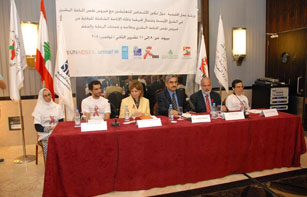
(From left to right): Zoheira Merah, an HIV activist and member of Al Hayat Association for People Living with HIV; UNAIDS Goodwill Ambassador Amr Waked; Hind Khatib, Director of the UNAIDS Regional Team for the Middle East and North Africa; Dr Walid Ammar, Director General of the Ministry of Public Health in Lebanon; Mr Elie Aaraj, President of the Regional/Arab Network Against AIDS; and Mr Moradi, a member of the Regional Resource Group for non-governmental organizations in the Middle East and North Africa. Credit: UNAIDS
HIV prevalence throughout most of the Middle East and North Africa remains low in the general population. In many settings, the epidemic is concentrated among key populations at high risk of infection, such as injecting drug users, men who have sex with men and sex workers. Exceptions to the general rule are evident in Djibouti, southern Sudan and parts of Somalia, where HIV prevalence now exceeds 1% among pregnant women in the general population.
Sixty participants from 18 countries across the Middle East and North Africa—including people living with HIV and UNAIDS Cosponsor organizations—gathered last week in Broumana, Lebanon, for a regional meeting focused on the empowerment of people living with HIV.
Supported by UNAIDS in collaboration with the Regional/Arab Network Against AIDS (RANAA), UNICEF, UNDP and USAID, the meeting focused on developing the leadership skills of people living with HIV with a view to advancing the vision of Zero new infections, Zero stigma and discrimination and Zero AIDS-related deaths. The participants pledged to strengthen coordination and partnerships with key actors, including government, civil society and faith-based organizations and the private sector.
Amireza Moradi, an HIV activist and participant in the meeting, applauded the efforts of people living with HIV in the region. “By our involvement as people living with HIV, we aspire to build a tolerant society,” he said.
A number of factors continue to hamper the HIV response in the Middle East and North Africa which can make people reluctant to access HIV services. These include stigma and discrimination, mandatory HIV testing, HIV-specific travel restrictions, human rights violations and gender inequalities. Although all countries in the region have established HIV treatment and care services, and provide treatment free of charge, the estimated coverage of treatment services is just 14%.
We are proud to be part of this positive movement in the region, and we will continue to support people living with HIV to have a louder voice
Hind Khatib, Director of UNAIDS Regional Team for the Middle East and North Africa
Despite challenges, there has been increasing commitment towards the HIV response in the region, as expressed through the Algiers’ declaration of people living with HIV in 2005, recommendations of a Tunisia regional meeting of people living with HIV in 2008 and a Dubai consensus statement on AIDS in 2010. In recent years, people living with HIV have made significant progress in organizing associations and advancing their rights.
Hind Khatib, Director of UNAIDS Regional Team for the Middle East and North Africa, reinforced the need to involve people living with HIV and key populations when developing HIV-related policies, strategies, and programmes as well as during implementation and monitoring and evaluation. “We are proud to be part of this positive movement in the region, and we will continue to support people living with HIV to have a louder voice,” she said.

Feature Story
400 000 deaths among people living with HIV due to TB in 2009
11 November 2010
11 November 2010 11 November 2010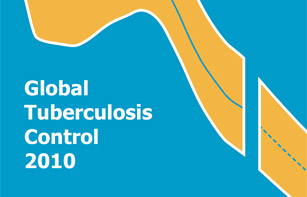
The latest WHO Global Tuberculosis Control Report 2010, launched today, highlights the need to reinvigorate efforts to prevent deaths from tuberculosis (TB) in people living with HIV. In 2009 there were an estimated 1.1 million cases of TB disease in people living with HIV, resulting in 0.4 million deaths. Yet TB is mostly preventable and curable.
According to the report, access to HIV testing, prevention, treatment and care for TB patients continues to expand. At least 75% of TB patients knew their HIV status in 55 countries, including 11 African countries such as Burkina Faso, Cote d’Ivoire, Mozambique and Zambia.
There are other examples of good practice. Namibia has improved its monitoring and evaluation systems and has reported around 15 000 people living with HIV are on isoniazid preventive therapy (IPR) in 2009. This therapy can prevent and reduce active TB among people living with HIV.
UNAIDS and Cosponsors have set an ambitious target of halving TB deaths in people living with HIV by 2015. This report highlights the need for us to work together on bold actions to achieve this goal
Alasdair Reid, UNAIDS HIV/TB Adviser
"The findings in the Global Tuberculosis Control 2010 publication confirm that when WHO's best practices are put in place, and with the right amount of funding and commitments from governments, we can turn the tide on the TB epidemic," said Dr Mario Raviglione, Director of the WHO Stop TB Department.
However, globally only 26% of TB patients knew their HIV status in 2009. People living with HIV who know their HIV status can benefit from appropriate treatment. In 2009 only about 140,000 HIV-positive TB patients were treated with antiretroviral therapy, this is only about 40% of all people living with HIV co-infected with TB.
“UNAIDS and Cosponsors have set an ambitious target of halving TB deaths in people living with HIV by 2015. This report highlights the need for us to work together on bold actions to achieve this goal,” said Alasdair Reid, UNAIDS HIV/TB Adviser.
Related
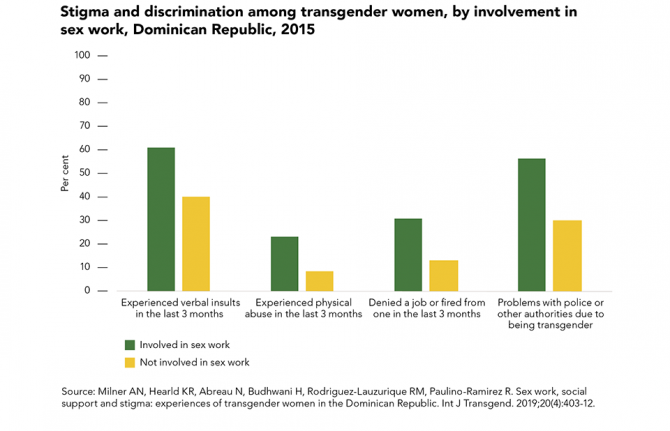 Transgender sex workers face frequent abuse
Transgender sex workers face frequent abuse

29 March 2022
 Many key populations avoid health services
Many key populations avoid health services

21 February 2022

Feature Story
Rwanda launches Agenda for Accelerated action for Women and Girls in the Response to HIV
10 November 2010
10 November 2010 10 November 2010
First Lady of Rwanda greeting Proffesor Tlou, UNAIDS ESA Director, together with Dr Sezibera, Minister of Health. Credit: UNAIDS
Rwanda’s National Accelerated Plan for Women, Girls, Gender Equality and HIV 2010-2014 was unveiled on 10 November at an event at the Parliament, in the capital Kigali.
The event was presided over by the First lady of Rwanda, Ms Jeannette Kagame, along with the Speaker of the Rwandan Parliament, Ms Rose Mukantabana, the Minister of Health, Dr Richard Sezibera, and the Executive Secretary of the National AIDS Control Commission, Dr Anita Asiimwe, in front of members of both chambers of the Rwandan Parliament.
The broad range of representatives present at the launch echoed the diverse stakeholders involved in the plan’s development, including national institutions, development partners, civil society organizations, and the private sector.
The First lady commended the commitment of the Ministry of Health, the National AIDS Control Commission, development partners, and civil society organizations in responding to HIV through an evidence-informed approach.
Some 3% of the adult population in Rwanda is living with HIV and in urban areas HIV prevalence as high as 7.3%. HIV prevalence in women is 3.6%, which is significantly higher than in men, at 2.3%.
Rwanda can not stop the spread of HIV without addressing women and girls and highlighted the importance of ensuring equitable allocation of resources, women’s participation in decision-making, and engagement of men and boys to address harmful gender norms
Ms Jeannette Kagame, First Lady of Rwanda
“Rwanda can not stop the spread of HIV without addressing women and girls and highlighted the importance of ensuring equitable allocation of resources, women’s participation in decision-making, and engagement of men and boys to address harmful gender norms,” said the First Lady.
Young women are far more often infected by HIV than young men, and in urban areas HIV prevalence is 3.9% among young women versus 1.1% among young men.
In her opening remarks, the Speaker of the Parliament noted, “I am convinced that great efforts have been made in our country to stop the spread of HIV and to take care of those infected or affected. However, there is still a long way to go to achieve the objective of an AIDS-free generation.”
In addressing those gathered, the Director of the UNAIDS Regional Support Team for Eastern and Southern, Professor Sheila Tlou, also commended the leadership and evidence-informed planning shown by the Government of Rwanda in its HIV response.
Rwanda has been selected by UNAIDS as a champion country globally, to share lessons with and inspire the work of other countries on the agenda for accelerated country action.
Professor Tlou recognized the ambitious goals of Rwanda’s National Strategic Plan on HIV and AIDS 2009–2012 of reaching 60% of sex workers with prevention programs, increasing condom use to 93%, and raising comprehensive knowledge of HIV to 70% by 2012.
We recognize, without question, that focusing on reducing infections among women and girls, does not mean not working with men and boys
Professor Sheila Tlou, Director of the UNAIDS Regional Support Team for Eastern and Southern
“We also recognize, without question, that focusing on reducing infections among women and girls, does not mean not working with men and boys,” said Professor Tlou.
According to the recent Behavior Surveillance Survey (2010), HIV prevalence among sex workers in Kigali city is 59%, rising to over 90% among people aged 35 and over. In relation to this, the Minister of Health, Dr Richard Sezibera, highlighted the fact that the response to HIV is not an academic exercise; it is “a fight that brings benefit to individuals in our country.”
Related

Feature Story
Bridging the health gap in South Africa
09 November 2010
09 November 2010 09 November 2010A longer version of this article appeared in the November Bulletin of the World Health Organization

Credit: UNAIDS
When she was four years old, Thando* was taken to a public hospital in Johannesburg for HIV treatment. “I first saw her in 1998 with advanced disease and her CD4 count was less than 50,” says Ashraf Coovadia, a paediatrician at the Rahima Moosa Mother and Child Hospital. “In 1999 we managed to get her antiretrovirals (ARVs) through a research project.”
Prior to 2003, ARVs were not available in the public health system in South Africa, the country with the highest number of people with HIV in the world. While private patients could get access to the life-saving drugs and buy their survival, many patients in the public sector did not survive.
It is this stark public–private divide that the South African government hopes its proposed National Health Insurance (NHI) scheme will tackle by providing universal access to health care “based on need rather than ability to pay.”
The starting point for the NHI is to close the increasing gap between the rich and the poor
Dr Aaron Motsoaledi, Minister of Health of South Africa
Thando was lucky to get therapy in time and this “lovely teenager”, raised by her aunt, is the longest attending patient at the hospital’s paediatric clinic. “Prior to the rollout, we had a handful of children accessing ARVs, less than 5%. Now the majority who need it are on ARVs and doing well,” says Prof Coovadia.
Access to treatment for HIV has expanded dramatically in the past decade and, since the 1994 democratic elections, access to health services in general have improved for poorer South Africans. However, some believe that the standard of care in the public sector has been steadily deteriorating.
“South Africa has had difficulty post 1994 in grappling with the HIV epidemic—that was a real curveball,” says Helen Schneider, Chief Researcher at the University of Cape Town’s (UCT) Centre for Infectious Diseases Epidemiology and Research.
South Africa has had difficulty post 1994 in grappling with the HIV epidemic—that was a real curveball
Helen Schneider, Chief Researcher, Centre for Infectious Diseases Epidemiology and Research.
Health Minister Aaron Motsoaledi told the Bulletin: “the starting point for the NHI is to close the increasing gap between the rich and the poor. If I am sick, I get the best care. If people are unemployed, they can forget it.” Dr Motsoaledi describes the existing health-care system as “very expensive, destructive, unaffordable and not sustainable.”
In September 2010, the ruling African National Congress (ANC) released its current proposals for the NHI for wide consultation. According to Zweli Mkhize, chairman of the ANC’s health committee, the scheme, which aims to provide universal coverage for all South Africans, is expected to cost an extra R11 billion on top of the R117 billion in the government’s health budget for 2012. Taxation to pay for this compulsory medical insurance scheme is expected to start in 2012, with a plan to phase it in over 14 years.
A private economic consultancy, Econex, has published an extensive critique of the proposals, teasing out some of the implementation challenges, chief among them the enormous anticipated cost of the system as currently conceptualized.
And cost models produced for the Congress of South African Trade Unions, which strongly supports the introduction of NHI, suggest an additional funding requirement of around R189 billion, before administrative savings.
The NHI would also introduce new dimensions to the South African health financing system, notably the possibility of using public resources through strategic purchasing of services for the population. According to Di McIntyre, a professor from UCT’s Health Economics Unit, this would ensure that “everyone will be able to access health services on the basis of their need for care and not on the basis of their ability to pay.”
*Thando’s name has been changed.
Related

Feature Story
Prevention Revolution
09 November 2010
09 November 2010 09 November 2010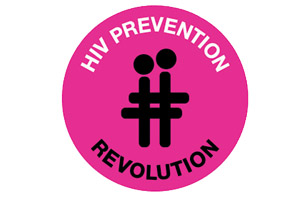
This is the third of five animated films for the social media initiative “HIV #PreventionRevolution”, that UNAIDS is running in the lead up to World AIDS Day 2010.
The aim is to inspire and encourage people using social media to know more about HIV prevention. The collective goal is to make the hashtag #PreventionRevolution shared as much as possible on 1 December 2010.
For the past two weeks, conversations have focused on why an HIV prevention revolution is needed and condom programming, under key messages such as “80% of HIV transmission is sexual” and “More than 7 000 people are infected with HIV everyday”.
It has connected tweeters such as @UN, @MTVStayingAlive, @Oxfam and @AnnieLennox.
Most importantly the conversation has engaged twitter users from all walks of life; all tweeting about the Prevention Revolution at the same time across at least five continents!
People on twitter have shared personal stories, called out for action on local level and the tweets seem to be sharing information that users did not previously have. For example:
@LoganLevkoff, tweeted: “Unacceptable,” in reply to the fact that only 1 in 3 young people have knowledge of how HIV is transmitted.
@0newinfections, a person on twitter living with HIV who uses twitter, urged his followers to join the conversation:
“I often wonder how long will i live. I became HIV positive when i was 25. Maybe 10 years more or 20? Be a part of the #PreventionRevolution”
Users have also come up with a new word on twitter “Edutweeting,” made from Education and Tweeting for what the initiative is trying to achieve.
This week’s discussion starter is the animated film Light, embedded above. Follow the conversation on twitter here and by visiting UNAIDS on Facebook.

Feature Story
Michael Ballack given prestigious award for his advocacy work on AIDS
08 November 2010
08 November 2010 08 November 2010
Michael Ballack, the captain of the German national football team and UNAIDS Goodwill Ambassador, has been awarded the famous German prize “sportler mit Herz,” or ”athlete with heart”, for his committed and outstanding work with UNAIDS.
The award was presented on 6 November 2010 before an audience of almost 3000 which included personalities from the world of sport, art and entertainment as well as national politicians.
At the reception, Mr Ballack said he was honored by the award, and accepted it on behalf of his UNAIDS colleagues.
UNAIDS has a vision of Zero new infections, Zero discrimination and Zero AIDS-related deaths. This is a vision that I share and I am proud to be doing my part to help
Michal Ballack, UNAIDS Goodwill Ambassador
“UNAIDS has a vision of Zero new infections, Zero discrimination and Zero AIDS-related deaths. This is a vision that I share and I am proud to be doing my part to help,” Mr Ballack noted.
A UNAIDS Goodwill Ambassador since 2006, Mr Ballack along with fellow international soccer player Emmanuel Adebayor, focuses on raising awareness about HIV prevention among young people. As a role model for young men around the world, he has participated in a number of campaigns to raise awareness on how to prevent HIV.

Feature Story
2010 Human Development Report: 40-year trends analysis shows many countries making gains but some losing ground
05 November 2010
05 November 2010 05 November 2010A version of this story first appeared at undp.org

Most developing countries made dramatic yet often underestimated progress in health, education and basic living standards in recent decades, with many of the least developed countries posting the greatest gains. This is one of the key findings revealed in the United Nations Development Programme (UNDP) 2010 Human Development Report, released 4 November.
However, despite significant progress in some countries, patterns of achievement vary greatly, with some nations losing ground since 1970, the report shows. The 20th anniversary edition, which introduces three new indices for inequality, gender and poverty, documents wide inequalities within and among countries and deep disparities between women and men on a broad range of development indicators. It highlights the prevalence of extreme multidimensional poverty in South Asia and sub-Saharan Africa and the AIDS epidemic is also shown to have had a marked negative impact on progress in some countries.
The Human Development Reports have changed the way we see the world
UN Secretary General Ban Ki-moon
The report, called The Real Wealth of Nations: Pathways to Human Development, was launched by UN Secretary-General Ban Ki-moon, UNDP Administrator Helen Clark and Nobel laureate Amartya Sen who helped devise the HDI for the first Human Development Report in 1990 with the late economist Mahbub ul Haq, the series founder.
“The Human Development Reports have changed the way we see the world,” Ban Ki-moon said. “We have learned that while economic growth is very important, what ultimately matters is using national income to give all people a chance at a longer, healthier and more productive life.”
According to Helen Clark, “The report shows that people today are healthier, wealthier and better educated than before. While not all trends are positive, there is much that countries can do to improve people’s lives, even in adverse conditions. This requires courageous local leadership as well as the continuing commitment of the international community.”
The report shows that people today are healthier, wealthier and better educated than before.
Helen Clark, DP Administrator
Overall, as shown in the report’s analysis of all countries for which complete HDI data are available for the past 40 decades, life expectancy climbed from 59 years in 1970 to 70 in 2010, school enrolment rose from just 55 percent to 70 percent, and per capita GDP doubled to more than US$ 10,000. Several poorer countries have registered substantial gains in education and public health, including Benin, Cambodia and Ethiopia, which ranked 11th in progress over time.
The region with the fastest HDI progress since 1970 was East Asia, led by China and Indonesia. A number of countries in sub-Saharan Africa and the former Soviet Union lagged behind, however.
“We see great advances, but changes over the past few decades have by no means been wholly positive,” the authors write. “Some countries have suffered serious setbacks, particularly in health, sometimes erasing in a few years the gains accumulated over several decades... And the gaps in human development across the world, while narrowing, remain huge.”
Related
 Transgender sex workers face frequent abuse
Transgender sex workers face frequent abuse

29 March 2022
 Many key populations avoid health services
Many key populations avoid health services

21 February 2022

